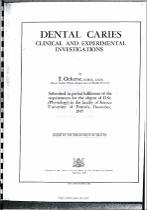Dental caries clinical and experimental investigations
Abstract
pental caries is the most prevalent of all diseases among civilized peo_ple. ~_n_ol
middl~~-~o=~ay with ~full c<?_P.plement of !fu.rty-t~~.J>§rfectly healthy tee!h. From various statistics obtained
ffo·m- practically every country in the world, the incidence is estimated to be over 95 per cent. By this is meant
that more than 95 ont of every 100 persons suffer or have suffered at some time from one or more carious teeth.
Statistics are based mostly on dental examinations of school children, because of the obvious difficulty of examining
large groups of adults for dental defects. There is a lamentable lack of reliable and accurate statistics concerning
the incidence of dental caries in most civilized countries.
Klein and Palmer (1938) reported that the incidence of dental caries (as defined above) among elementary
school children in the United States is 95 per cent. Day and Sedwick (1935) found the incidence among Rochester
(N.Y.) schoolchildren to be 99 per cent. The final report of the Mixed Committee of the League of Nations
of 1937 shows that in Norway, of 25,000 school children examined, only 160 possessed perfect sets of teeth, or
99 per cent. affected by dental caries. Day and Sedwick (1935) state that, in the county of Shropshire in England,
97 per cent. of the children at the age of 12 had dental caries. The Director-General of Health of New Zealand,
in .his annual report of 1941, states that of 52,500 children examined, 95 per cent. were affected by caries: In
India, Day and Tandan (1940) reported that the incidence of dental caries among urban children in Labore was
94 per cent. In South Africa, Friel and Shaw (1931) found 93 per cent. of urban children suffering from dental
caries. Staz (1938) reported that of 300 European adults examined in Johannesburg none showed caries-free
mouths.

